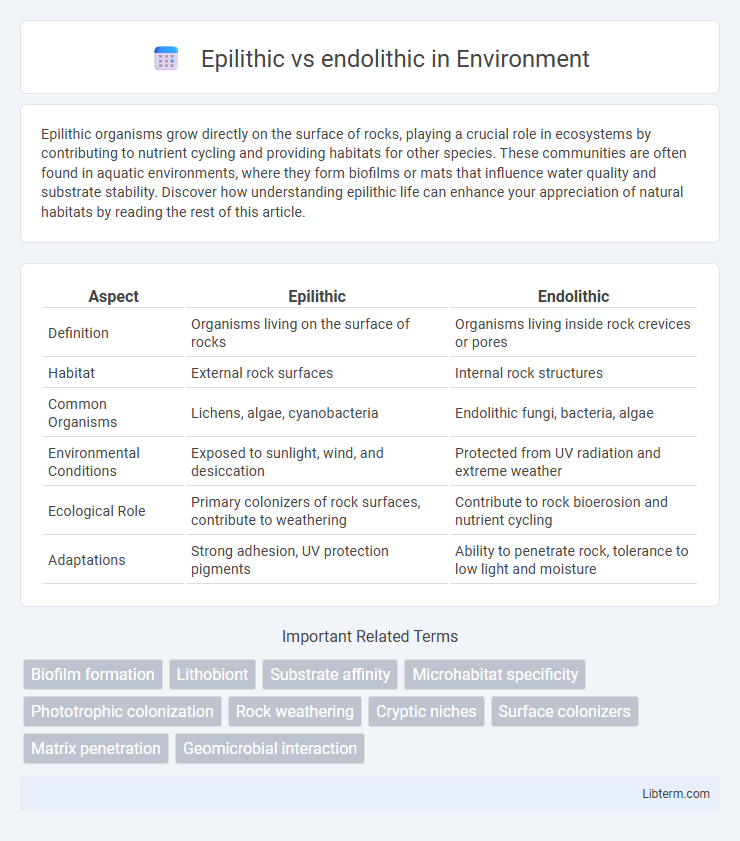Epilithic organisms grow directly on the surface of rocks, playing a crucial role in ecosystems by contributing to nutrient cycling and providing habitats for other species. These communities are often found in aquatic environments, where they form biofilms or mats that influence water quality and substrate stability. Discover how understanding epilithic life can enhance your appreciation of natural habitats by reading the rest of this article.
Table of Comparison
| Aspect | Epilithic | Endolithic |
|---|---|---|
| Definition | Organisms living on the surface of rocks | Organisms living inside rock crevices or pores |
| Habitat | External rock surfaces | Internal rock structures |
| Common Organisms | Lichens, algae, cyanobacteria | Endolithic fungi, bacteria, algae |
| Environmental Conditions | Exposed to sunlight, wind, and desiccation | Protected from UV radiation and extreme weather |
| Ecological Role | Primary colonizers of rock surfaces, contribute to weathering | Contribute to rock bioerosion and nutrient cycling |
| Adaptations | Strong adhesion, UV protection pigments | Ability to penetrate rock, tolerance to low light and moisture |
Introduction to Epilithic and Endolithic Organisms
Epilithic organisms grow on the surface of rocks, forming visible biofilms or crusts that contribute to ecosystem functions like nutrient cycling and soil stabilization. Endolithic organisms inhabit the interior of rocks, penetrating pores and fissures to survive in extreme environments by accessing microhabitats protected from harsh external conditions. Both epilithic and endolithic lifestyles demonstrate unique adaptations that enable colonization of lithic substrates, playing critical roles in biogeochemical processes and rock weathering.
Defining Epilithic: Life on Rock Surfaces
Epilithic organisms live on the external surfaces of rocks, thriving by attaching themselves to exposed mineral substrates where sunlight and nutrients are accessible. These communities include lichens, algae, and cyanobacteria, playing critical roles in weathering processes and ecosystem nutrient cycles. Their presence influences rock surface microenvironments by stabilizing sediments and contributing to biological soil crust formation.
Understanding Endolithic: Life Within Rocks
Endolithic organisms live inside the pores and cracks of rocks, adapting to extreme environments by penetrating mineral substrates for protection and moisture. This internal habitat distinguishes them from epilithic organisms, which reside solely on rock surfaces exposed to external conditions. Endolithic life forms contribute to rock weathering and nutrient cycling, playing a critical role in ecosystem dynamics within arid and polar regions.
Habitat Differences: Surface vs. Subsurface
Epilithic organisms inhabit the surface of rocks, thriving exposed to sunlight, air, and varying environmental conditions, which supports photosynthetic life such as lichens and algae. Endolithic organisms live beneath the rock surface, often within microscopic crevices or pores, allowing them to avoid harsh surface conditions and desiccation while relying on limited light and nutrient availability. These distinct habitats create unique ecological niches, influencing adaptation strategies and biodiversity patterns between epilithic and endolithic communities.
Adaptations for Survival
Epilithic organisms adapt for survival by developing strong attachment mechanisms and protective pigments to withstand UV radiation and desiccation on exposed rock surfaces. Endolithic species survive by penetrating porous or fissured substrates, benefiting from the stable microenvironment and moisture retention within the rock. Both strategies optimize resource utilization and protection, enabling life in extreme conditions.
Ecological Roles and Functions
Epilithic organisms, found on rock surfaces, play crucial roles in nutrient cycling and habitat formation by fostering microbial communities that support higher trophic levels. Endolithic organisms penetrate rock substrates, contributing to bioerosion and mineral weathering processes that facilitate soil formation and ecosystem development. Both types serve as pioneers in harsh environments, enhancing biodiversity and stabilizing microhabitats in extreme ecological niches.
Methods of Study and Identification
Epilithic organisms are studied through surface imaging techniques such as scanning electron microscopy (SEM) and high-resolution photography to analyze biofilm and microbial mats on rock surfaces. Endolithic organisms require methods that penetrate rock matrices, including micro-CT scanning, thin-section petrography, and DNA extraction from rock samples to identify microorganisms residing within rock pores. Molecular techniques like PCR and fluorescence in situ hybridization (FISH) enable precise identification and differentiation between epilithic and endolithic microbial communities.
Environmental Impacts and Interactions
Epilithic organisms live on rock surfaces, influencing weathering processes and contributing to nutrient cycling by trapping moisture and organic matter, which supports microhabitats. Endolithic organisms inhabit the interior of rocks, altering mineral composition through bioerosion and enhancing rock porosity, which affects rock stability and soil formation. Both play crucial roles in ecosystem interactions by facilitating microbial colonization and impacting rock decay rates in various environmental conditions.
Epilithic and Endolithic Organisms in Extreme Environments
Epilithic organisms colonize rock surfaces, thriving by exploiting sunlight and moisture in extreme environments such as deserts and polar regions. Endolithic organisms inhabit the interior of rocks, gaining protection from harsh conditions like intense UV radiation and temperature fluctuations by residing within microscopic rock pores. Both types of organisms contribute significantly to bio-weathering and nutrient cycling in ecosystems where other life forms struggle to survive.
Significance in Biodiversity and Evolution
Epilithic microorganisms, living on rock surfaces, play a critical role in ecosystems by contributing to nutrient cycling and providing habitats for diverse microfaunal communities, which enhances biodiversity. Endolithic organisms inhabit the interior of rocks, offering insights into evolutionary adaptation by surviving extreme conditions, thereby expanding our understanding of life's resilience and evolutionary processes. Both forms of lithic colonization contribute significantly to ecological succession and biogeochemical cycles, influencing biodiversity and evolutionary dynamics across terrestrial and marine environments.
Epilithic Infographic

 libterm.com
libterm.com